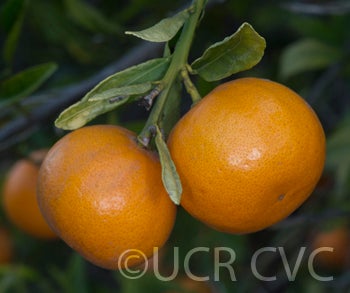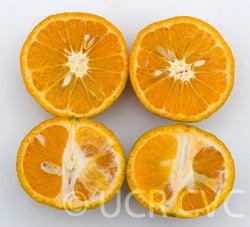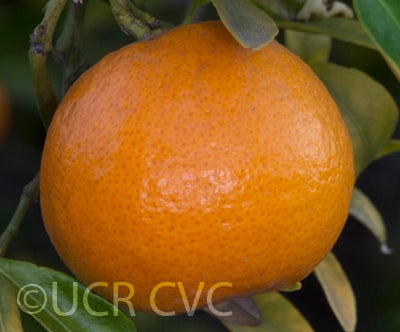Citrus reticulata Blanco RUTACEAE
CRC 3020
PI 539499
VI 66
Source
Received as budwood from the Citrus Research Center, Riverside, Calif., 1935.
Parentage/origins
King tangor x Willowleaf mandarin
Rootstocks of accession
Carrizo citrange, C-35 citrange
Season of ripeness at Riverside
January to March
Description from The Citrus Industry Vol. 1 (1967)
"Fruit small to medium in size, slightly oblate; base flattened and somewhat furrowed; apex flattened or moderately depressed. Rind medium-thin, somewhat brittle, somewhat adherent but readily peelable; surface slightly pebbled, glossy.; orange-colored at maturity. Segments 9 to 12, firm but separating easily; axis semi-hollow. Flesh color deep orange; very juicy; flavor rich, sprightly, aromatic, and distinctive. Seeds moderately numerous, monoembryonic, and cotyledons greenish-yellow to yellow-tinged. Midseason in maturity (about like Kinnow). Retains quality and stores well on tree but with some puffing.
Tree moderately vigorous, medium in size, round-topped, nearly thornless; leaves long, broadly lanceolate, and taper-pointed. Strong tendency to alternate bearing with small fruits in the on-crop seasons and little or no fruits in the off-crop years. Cold-resistant.
A sister to Kinnow, both resulting from a cross of King X Willowleaf (Mediterranean) made in 1915 by H. B. Frost (1935) of the University of California Citrus Research Center, Riverside, this richly flavored variety has been widely distributed, but with minor exceptions has not achieved commercial importance. Wilking is reported to have done well commercially, however, in the Souss Valley of Morocco and is considered promising in Brazil."
Availability
Commercially available in California through the Citrus Clonal Protection Program. Click here to order budwood.
USDA Germplasm Resources Information Network page for Wilking mandarin




